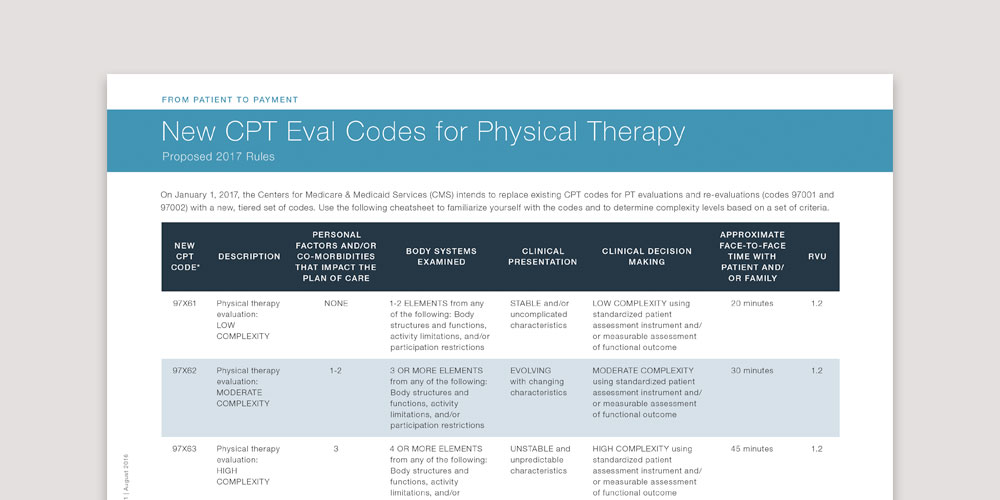Like the times, CPT evaluation codes are a changin’.
Starting on January 1, 2017, CMS will replace existing CPT codes for PT and OT evaluations and re-evaluations (codes 97001- 97004) with three new evaluation codes and a new re-evaluation code.
The new codes are intended to pay OTs and PTs more for complex treatments, rather than time expended on an individual patient. For example, the three codes that replace the current 97001 PT evaluation code reflect three levels of patient presentation:
- low-complexity (97161)
- moderate-complexity (97162)
- high-complexity (97163)
Therapists register the complexity of their treatments by reporting factors such as patient history, examination, clinical presentation, and clinical decision making.

Looking for an easy way to remember new CPT eval codes for Physical Therapy? Download this handy cheat sheet to familiarize yourself with the new codes.
Download nowReport on Complexity, Even if You’re Not Reimbursed for It- Yet
Sometimes the goal of policy reform and its outcome don’t match up. One of the goals of creating these complexity stratified evaluation codes was to reimburse therapists more equitably for managing complex patients. But the tiered evaluation codes don’t currently correspond to tiered payment values.
Since therapists are not being paid any more for evaluation that is high complexity, some may be tempted to report that all are low complexity. Don’t make this mistake.
CMS will be analyzing the proportion of codes submitted and will ultimately make decisions on stratifying the relative value for each code. CMS will make this calculation “revenue neutral”. In other words, the same amount of total money will be distributed between the three evaluation codes based, in part, on the frequency that they are reported. If there is widespread “undercoding”, CMS will assume most of the patients PTs and OTs see are low complexity, and that high complexity evaluations are relatively rare.
December Must Do: Practice the New CPT Codes
While you won’t have to face these changes until January 2017, therapists should practice using them now. Familiarize yourself with the evaluation complexity matrix and run through case studies to develop a comfortable understanding.
Check out Clinicient’s comprehensive CPT Eval Codes Cheat Sheet to help guide your preparation.

Comments